Withens Lane, 1938 |
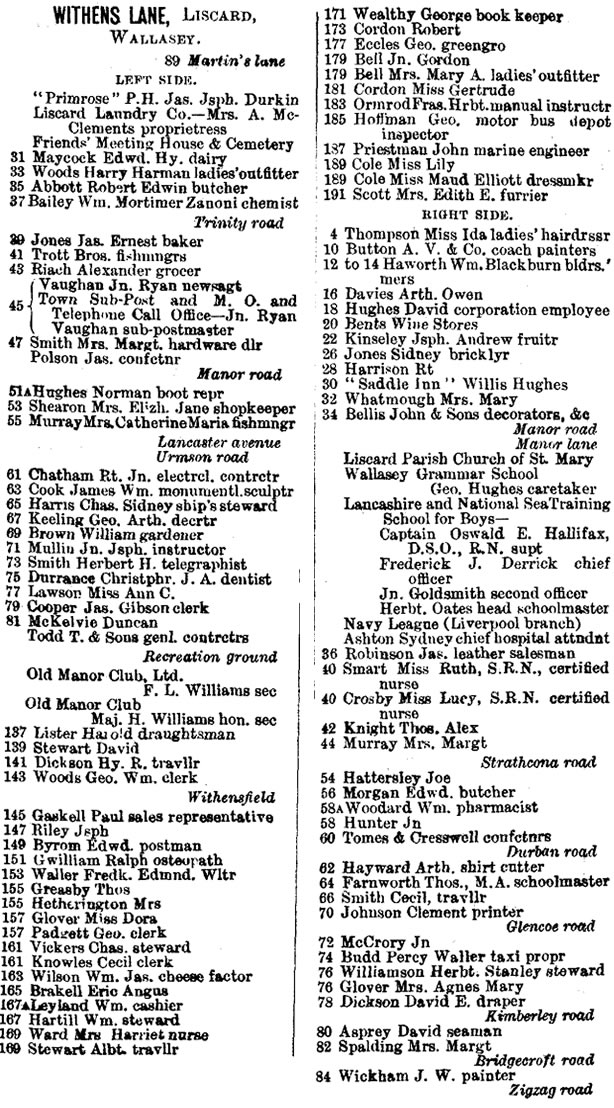 |
Withens Lane
Withens Lane is named after a field which today is covered with roads and houses that were built in the early 1900's. Where Glencoe Road and Durban Road is today cattle use to graze on the land. Bridgecroft Road gets its name from another field which had, no doubt, a small bridge of sorts that cross a stream.
Beginning from the Zig Zag Road end on the right-hand side there are a number of interesting houses. At No. 179 was possibly called 'Hawthorne Villa' at one time. The property dates from about 1872. In 1899 Septimus and Hannah Wharrie lived in the villa. In previous years they both also lived at No. 3 Withensfield Terrace and at Bootle View. It was formerly the home of William McIntyre the paint and and oil manufacturer. He lived there soon after the villa was built. In 1904 Tom Whittingham, a stone mason, lived at the villa.
Situated at Nos 175-177 is the fine sand-stone built three-storey 'Bootle View' which is so-called because of the view of Bootle from the bedroom windows. The houses on the opposite side of the road had not yet been built. Waste land and fields stretched down to the River Mersey. The property dates from about 1830 with an extension on each end of the range being added some years later which thus created Nos. 179 and 173. In the 1860's the property was divided into three dwellings with Anne Elizabeth Price running it as a lodging house. Ann actually lived in 'Rose Cottage' lower down the lane. In one of the divided properties lived William Dickson who was a tailor. who fell in love with Anne Groom from Withensfield Cottage, which was a little lower down the lane, and got married. Other people who lived at Bootle View over time included a book-keeper Samuel Wright, the gardener John Hughes, a corn broker William Broome, the merchant James Sweedie. Mrs Margaret Miller of the Ladies Academy also lived here as well as Septimus Wharrie.
No. 173 was built about 1870 and seems to have had two or three different names - 'Heather Croft', 'Heather Villa', and possibly 'Bootle Mount'. In 1900 the Reverend Joseph Lloyed resided there.
At No. 171 was 'Clydesdale' which was built about 1875. For a number of years Charles Leonard Wade resided there until the 1920s. He was an estate agent. In 1935 Geoege Wealthy, a book-keeper, lived at the house.
No 169 was 'Staltoe' and was built at the same time as 'Clydesdale'. In 1911 Alexander Sculli, managing director, lived there. For a time John Kennedy, F.R.G.S., lived in the house for awhile. He was a manager and was followed in 1926 by Carl Bloemental.
Behind No. 167 stood 'Rose Cottage' and was built before 1841 and was once known as 'Bidston View' because you was able to see the Bidston Windmill from the garden. The stables were built at the same time. In 1851 an elderly coiuple, John and Martha Walthew, lived there with their daughter Penelope Price and son Thomas, a cotton broker. Penelope's sixteen year old daughter, Anne, also lived with them. In 1865 she was running a lodging house in Withens Lane. In 1867 George Grove Blackwell, a mineral broker, bought 'Rose Cottage' from Charles Baldwin. The sale of the cottage included the stables. George Blackwell paid £330 for the property. In 1873 he decided to build a large house on the land facing the lane and called it 'The Groves' which cost about £1,350. George and his large family remained there until 1891 when they moved from the property which was then bought by Messrs Charles and Charles Hibbert Birchall, the publishers, for the price of £950. The house was renamed as 'Inveresk'. It was let out to the other people before the Birchall family came to live in the house in the 1900s. By 1906 Charles Birchall sold the house to Thomas Valentine Burrows for £625. Thomas Burrows was a member of the old Wallasey Council and was Mayor of Wallasey between 1913-14. He let the house to Alfred Morris, a carriage proprietor. In 1913 Burrows made 'Inveresk' into two dwellings - becoming No. 167 and 167a. Later No. 167 was made into two separate flats, numbered 167a and 167b. Henry Sayle, a Liscard plumberand contractor, came to live at No. 167a and used the old cottage at the rear as a workshop which was then a stable and hay loft. It was eventually demolished in 1978 by Mr Sayle's two sons.
Next, at No. 165, is 'The Withens' which used to be called 'Withensfield Cottage' and was originally built in about 1830. At the time of the beginning of the First World War the cottage went through some changes, being enlarged with bay windows added. In 1851 John and Jane Groom lived there with their three children, Anne, Wilkinson and John. John Groom was a joiner by trade. Anne married William Dickson, who was a tailor and draper and a partner in the business of Hughes and Dickson and went to live at Withensfield Terrace. They had eleven children. Alfred and Harriet Daish and their three children and a niece lived at the house. By 1904 John Holmes, a journalist, was living there. Eric Angus Bakewell lived in the house from the 1920s right up to the 1960s.
Next door was No. 163 and this was the home of Charles Farrar, M.R.C.V.S.Lon., the veterinary surgeon. The large house has been known as 'Withensfield Villa', 'Withenscroft' (the stone with this name on can still be seen in the low front wall) and 'The Manse'. it was called by the later name because it was the manse of the Egremont Presbyterian Church at one time when the Reverend James Goold M.A. lived there in 1904. In 1893 Thomas Harling, the ship-owner, lived at the house.
Numbered between 155 to 161 is 'Whithensfield Terrace' and date from about 1855-65. The houses are built of sandstone and are two-storey high with attics above. In 1868, Miss Mary Barton was living at No.1, Edward McArdle, a cotton broker, lived next door at No.3 and at No. 4 lived a cotton broker, William Dunne Broome.
The side entry that leads to the cottage is really Withensfield Place, but today no one uses that name. There was also a number of houses in Withens Lane which were known as Clifford Terrace.
No. 153 is a small cottage which is approached by an entry at the side of No. 155. At one period it was known as 'Withensfield Cottage' amd was built in the latter of the nineteenth century. The cottage faces north and has a large garden in front. It had been modernised over the years. John Gregson lived here at one time, as did William Graham Hope in the late 1800's to the early 1900's. Wilfred Booth followed, then Mrs. B. Whaites. Both stayed only a few years, then in 1907 Walter Scott was living there.
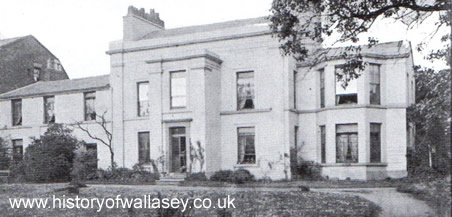 |
Withensfield House, c1905 |
'Withensfield House' stood where the small cul-de-sac called Withensfield is. John McClelland lived there in 1894, Between about 1864 to 1883 it was a Ladies Academy, which was run by Mrs Margaret Miller. After a period of a few years as a private residence, it was opened as a Y.W.C.A. Holiday Home with Miss Mason as matron and Miss M.A. Belcher as Secretary. When the Y.W.C.A closed it became the Christian Alliance for Girls and Women in the 1920's. They were charged £1 8s. 0d. a week for young women such as typists and shop assistants. They had their own rooms and meals were provided. A reduced rate was given for thos who were not so well off, but they only had a cubicle and less meals. The property was demolished in about 1930.
The Old Manor Club used to have a bowling green (now a car park) at the side. Before it was a gentlemen's club, it was known as 'Heyfield House', where Charles Wheldan, the commercial traveller, lived.
The Delph playing fields were once a quarry which was called 'White Delph Quarry' and was owned by Mrs Maddock, the Lady of the Manor of Liscard. She gave the field to the town for children and others as a playing field. There was a pit on the Delph at one time which was later filled in. it stretched from Withens Lane to Rake Lane, on the opposite side of the cemetery gates. The word 'Delph', incidentally, means 'quarry'. Locals use to take shortcuts across the field and enter Scott Street by way of an entry. Football was played on the field in the winter and in the summer months boys use to play cricket. Several football teams used it, including Withensfield F.C. The Seventh Wallasey Scouts also played there.
The contractors, Tom Todd & Sons, had the yard at the bottom of the entry in the 1930's. Residing at No. 79 was the pilot, James Parkinson and James Cook was a monumental sculptor at No. 63.
Urmson Road, running from Withens Lane to Liscard Village, was once called Townfield Lane, after a field of that name which was at the top of the lane. Urmson Road takes its name from Urmson House which was once located in Liscard Village, facing Manor Road and was built in about 1729 by Farmer Urmson. The building was demolished in 1928.
At No. 59 lived Edwin Thomas Davis. He was the first trolley tram driver in Wallasey and he also drove the last tram in 1933 when they were replaced with buses.
Running off Withens Lane is Lancaster Avenue and it will always be known as the place where the baby survived the Blitz in the Second World War. Three month old baby Irene Foulds was found under the debris by rescue workers some three and a half days after the air-raid. There use to be a war memorial fastened on the wall of one of the houses near the top of the avenue on the left-hand side where the names of the men who had fallen in the First World War were listed.
On the corner of Lancaster Avenue was Murray's fishmongers shop. The business was started by Richard Murray and later his son, John, took over. He had a marble slab in the window for the fish. The Murrays would go out fishing on the Mersey in their own boats - 'Playmate', 'Greyhound' and 'Camelia'. When the boats were not being used they would be anchored in the river opposite the Mariners' Homes. They won many sailing cup races too.
Norman Hughes opened a boot repairing business on the corner of Manor Road at No. 51a Withens Lane in the 1930's. James Polson's confectioners was on the opposite corner. The Post Office was run by Mr and Mrs Vaughan. They went on to open several newsagents in the town. Their advertising slogan was "Every morn, think of Vaughan".
Jones the Bakers was on the corner of Trinity Road. The business was started by Lucy Jones in 1910 who came over from Liverpool. The property, like Trinity Road, was built in 1907. Later the business was run by her son, Harold. Mr Jones delivered the bread in a wooden cart which had two rear wheels and one front wheel. Later he invested in a Morris 'Commercial' van in the 1950's. On the opposite corner in the 1930s was William Bailey chemist.
Other shopkeepers at this time in the road were Robert Abbott, the butcher (No. 35), next door at No. 33 was Harry Woods ladies outfitters and Edward Haycock had the dairy.
The old Quakers' Church in Withens Lane was built in 1854 at a cost of £600. Designed by Thomas Smith, the chapel could hold six hundred people. The Quakers called their new chapel 'The Friends Meeting Place' and they remained there until it closed in 1973. There use to be gravestones both at the rear and front of the chapel. All the gravestones were plain and without decoration. Today the building is used as a day nursey.
The Liscard Laundry was run by James McClements. It is now the site of the British Legion Headquaters. Next to the premises is the 'Primrose Hotel'. It was once an ivy-covered cottage called 'The Primrose Tavern' and George Evanson was landlord in 1860. By 1894 Ann Mayman had the Inn. During the First World War Bill Lodge was the keeper of the public house. The Inn went through some alterations in 1923 including the pseudo Tudor-styling. Tom McInerney, the wrestler, once had the license and was a well-known star. After Tom died his wife, Amelia, carried on as landlady. James Durkin was the licensee in 1936. When a new sign was needed for the Inn in the 1980's, local artist, Bill Kennedy was commissioned to undertake the work. Instead of painting a bunch of primroses he thought that a more interesting study would be that of the old Wallasey ferryboat 'Primrose' which had been built in 1880.
On the opposite side of the road, at No. 84, there was a dentist on the corner of the Zig Zag Road named Harry Hughes. In this part of Withens Lane there were two small shops. On the corner of Bridgecroft Road was Mrs. Margaret Spaldings and on the corner of Durban Road was the three sisters (the two Miss Tones and Mrs Grenville) sweet shop.
The roads leading off from this side of Withens Lane are referred to as "Little Africa". So called because they are named after places in connection with the Boer War. Some of the names are Durban Road, Glencoe Road, Kimberley Road, Carrington Road (being named after General Carrington). Imperial Avenue gets its name from the Imperial Troops in the South African War.
The Lancashire and National Sea Training School for Boys was known as the 'Navy League' and was built on the old Clifton Hall Estate. The foundation stone was laid by Lord Strathcona and Mount Royal G.C.M., L.Ld., on 18th October 1902, and was opened the following year, being the first sea training home on land supported by the public.
In the early days "Fall-In" was sounded at 6.10 am. Physical drill followed. At 8.00 am, the colours were located and breakfast piped. The Home was divided into blocks:
A - The Liverpool Navy League Home
B - The Cheshire Home
C - The 'Herts Navy League' Home
D - The Sir Alfred Jones Memorial Home
E - The Hearh Harrison Technical Instruction Wing
F - The Sir Alfred Read Gymnasium
The 'Cheshire Home' building was opened in 1908 and was to have been opened by H.R.H Princess Louise, but had to be postponed. H.M. the King inspected the boys in July, 1905 as they formed a Guard of Honour to H.R.H, the Duke of Onnaught at Liverpool in July, 1906. The President of the Lancashire Sea Training Home was the Earl of Lathom and the Vice President was Sir Alfred Jones, K.C.M.G., the ship-owner.
When the Home opened in August 1903 there was just eight boys. After a week, more boys arrived and after a whole year they had a total of one hundred and seventy-five lads, of which thirty-nine were drafted to sea. The lads entered the Home at the age of 13 and a half. Those who went into the Navy left at fifteen and a half, while those who entered into the Merchant Navy went on until they were sixteen.
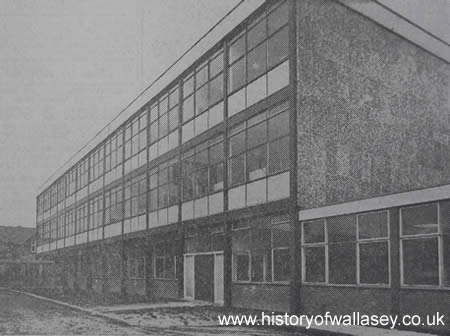 |
Wallasey Technical College, main building, January 1963. |
During the early part of the Second World War the Home was evacuated and the buildings were used for other training activities. In 1948 it was bought by the Wallasey Council for £29,000 and became the Wallasey Technical College, then later the Wallasey College of Further Education. It then became part of the North Wirral College Education until closing in 1997 and replaced with a housing estate.
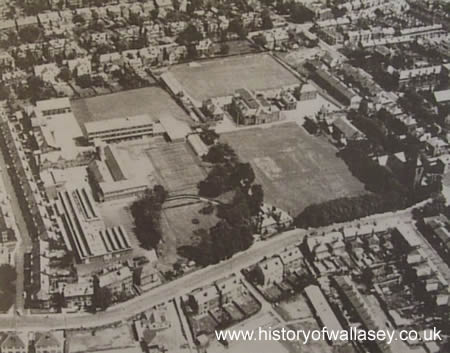 |
Wallasey Technical College, 1960's, next to Wallasey Grammar School |
Clifton Hall was a large grey house built in the 1840's and was set back from the lane (the sandstone wall still exists) with its own lodge (which still stands) and gates. Peter Wright, the Clerk of the Peace, resided here between 1857-65, as did Captain Heron of the Wallasey Ferries. The Hall was demolished by the 1950's.
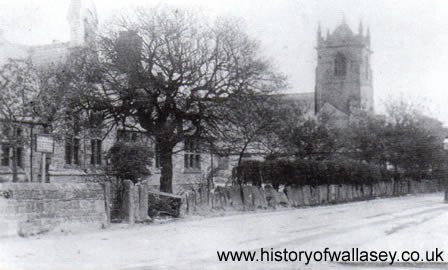 |
Withen's Lane was the third site for Wallasey School moving here from St. George's Road in 1876 - the buildings on the left, behind the tree, were replaced with new ones in 1911. St. Mary's Church is seen beyond. |
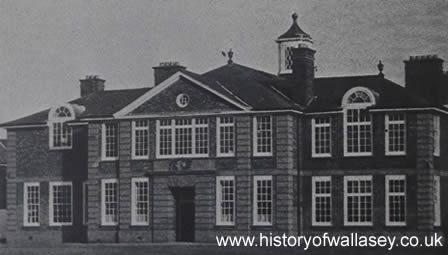 |
Wallasey Grammar School |
Liscard Primary School was once called Withensfield Primary School and before that the old Wallasey Grammar School, which was built on land which had been purchased from the Navy League. It opened on 14th January, 1911, replacing the older building which had stood on the "flag field" and which became the cricket pitch.
St. Mary's Church foundation stone was laid on 13th January, 1876 by Mrs. Mary Ann Maddock, Lady of the Manor of Liscard. The sandstone for the church came from Mrs. Maddock's White Delph Quarry in Rake Lane and the red sandstone from Runcord. The tower was begun in 1881 and completed a year later. By the time the church was consecrated on 13th December, 1877, it had cost £7,520. [Read more]
On the corner of Manor Road, at No. 34 Withens Lane, was John Bellis, the plumber. As time went on the firm expanded and his two sons came into business and became a successful establishment. They built a shop and house in 1894 (the house place in red brick carries the letter "B" and the date) with a yard attached.
John Clarke resided at 'Laburnum Cottage' (No. 32) in 1900. He was a gasfitter.
'The (Horse and) Saddle Inn' was once two small cottages. There still two front doors. The pub was run for three generations by the Hughes family between 1893 to 1973. [Read more]
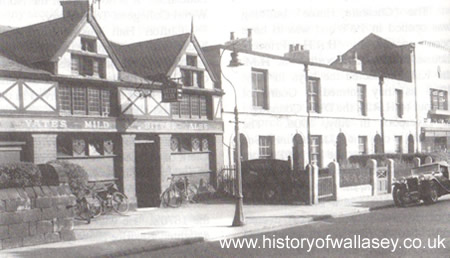 |
Saddle Inn to the right with Stafford Buildings on the left, pictured in the 1950's. |
Standing next to the Saddle Inn was 'The Barracks' which were really called Stafford Buildings. They were three storey high, though the top storey was removed after the Second World War. They were built at the same time as the Saddle Inn. At the rear of the building were further cottages with a yard and toilets Stafford Buildings were back-to-back; four facing the lane and four at the bac. They got their name 'Barracks' on account of once being used by the soldiers from Urmson Road.
A little further down Withen's Lane was William Blackburn Haworth Builders Merchants at No.12-14. It was an old family firm started in 1922. The first yard was situated close to Penny Bridge and from there moved to Wallasey Road near to the Wellington Hotel (Duke's). In 1932 they moved to Withen's Lane and took over the building of the Manor Road Motor Oil Company. The building merchants then moved to Cross Lane.
Featured sites
- Non Gamstop Casinos
- Casino Not On Gamstop
- UK Casinos Not On Gamstop
- Non Gamstop Casinos UK
- Sites Not On Gamstop
- Sites Not On Gamstop
- Casinos Not On Gamstop
- Casinos Not On Gamstop
- Casinos Not On Gamstop
- Non Gamstop Casino UK
- Casinos Not On Gamstop
- Non Gamstop Casino
- UK Online Casinos Not On Gamstop
- UK Online Casinos Not On Gamstop
- Non Gamstop Casinos
- Casino Sites Not On Gamstop
- Casinos Not On Gamstop
- Casinos Not On Gamstop
- Best Betting Sites
- Casinos Not On Gamstop
- Gambling Sites Not On Gamstop
- Betting Sites That Are Not On Gamstop
- Non Gamstop Casinos UK
- UK Online Casinos Not On Gamstop